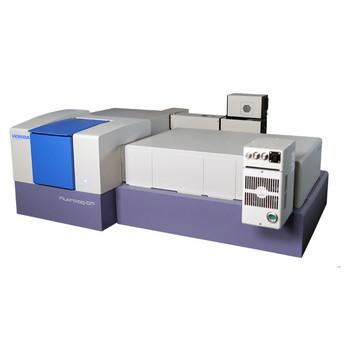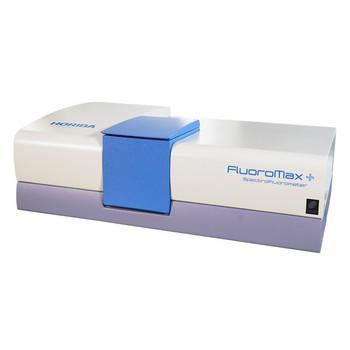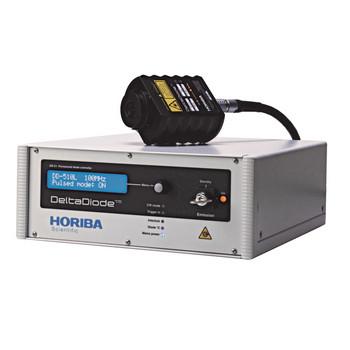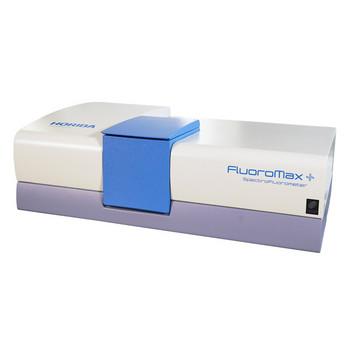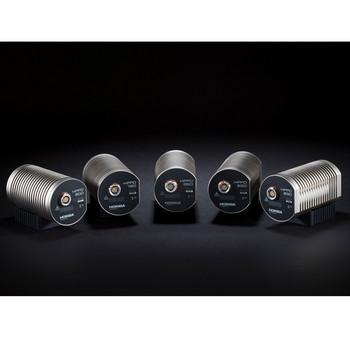Lamp Specifications
Lamp Power Supply
PTI RatioMaster lamp power supplies are highly-regulated DC units that provides very stable power for xenon, mercury, and mercury/xenon compact arc lamps as well as tungsten-halogen lamps.
| Lamp power capacity | 75 to 200 watts |
| Height | 100 mm (3.9 inches) |
| Width | 100 mm (3.9 inches) |
| Length | 210 mm (8.3 inches) |
| Weight | 1.9 kg (4.2 pounds) |
| Window diameter (D) | 65 mm |

DeltaRAM X™ Random Access Monochromator
PTI RatioMaster's exciting new DeltaRAM X™ represents the next bold step in the evolution of light sources. The compact, proprietary (patented) single monochromator design permits the selection of any single wavelength in two milliseconds or less. It is ideally suited for multi-wavelength applications as well as excitation scanning. It is easily controlled via a single low voltage signal line. Includes a 2-meter liquid light guide, for use with most microscopes and other sample handling devices. DeltaRAM X™ delivers powerful excitation wavelength from 250–650 nm under synch-lock computer control. Synch-lock control, locks the DeltaRAM X™ monochromator to the camera exposure or frame readout. The DeltaRAM X™ saves you money by not requiring purchase of additional excitation filters for each dye you wish to use. Synch-lock allows accurate timing to be retained between camera and illuminator.
Systems not synch-locked can be plagued with synchronization problems or latency due to operating events or user clicking events. Try this in another imaging software package, click and drag a window, either the illuminator will stop moving, or images will stop being acquired until the mouse button is released. This does not happen with PTI RatioMaster's sync lock!
| Excitation wavelength range | 250–650 nm |
| Optimum scanning range | 290–610 nm |
| Wavelength selection speed | < 2 milliseconds point-to-point |
| Resolution | < 1 nm |
| Accuracy | + 3/-1 nm |
| Wavelength bandwidth | Adjustable from 0–24 nm |
| Stray light rejection | > 104 |
| Light delivery | 0.5 meter quartz fiber optic bundle |
| Liquid light guide | 2 meter length 2 mm core diameter |
| Microscope adapter | User specified |
Liquid Light Guide
Spectral Transmission Curves

Specific Properties
| Series | Dia. | Properties | Recommended Light Sources | Applications | Temp Range |
|---|---|---|---|---|---|
| 300 | 2, 3 ,5 mm | Superior transmission of up to 5 W of UV radiation. Suitable for rugged environments | Hg and Xe short arc, Tungsten Halogen | UV Epoxy curing and fluorescence inspection, at lengths up to 20 meters. | -5 to +35°C |
| 380 | 2, 3, 5 mm | Excellent transmission from NUV to far red, at lengths to 30 m. Suitable for rugged environments | Xe short arc, Tungsten Halogen, Metal Halide | Outstanding white light illumination | -5 to +35°C |
| 2000 | 2, 3, 5 mm | Transmission of high power NIR in the multi-watt range. Protection required from high power radiation below 420 nm. Integrated long pass dichroic filters available | Xe short arc, Tungsten Halogen, Nd-YAG or diode lasers | Visible or NIR illumination at lengths to 10 meters | +5 to +35°C |
| 800 | 5 mm | Enhanced flexibility, no losses even with small bend radius. Protection required from high-powered radiation below 420 nm. Integrated long pass dichroic filters available | Tungsten Halogen, Xe short arc | Very High NA white light illumination, excitation of HPD in medicine. | +5 to +35°C |
Mechanical Dimensional Information
| Core Diameter | D1 | D2 | D3 | L1 | L2 |
|---|---|---|---|---|---|
| 2 mm | 4 mm | 8 mm | 5.5 mm | 6.7 mm | 20 mm |
| 3 mm | 5 mm | 9 mm | 7 mm | 20 mm | 24 mm |
| 5 mm | 7 mm | 10 mm | 9.5 mm | 20 mm | 24 mm |

Photometer
When you need to perform microscope photometry, what do you use? Most labs end up acquiring some microscope accessory intended for another purpose—such as photography.
Unfortunately, these devices are rarely up for the task. Microscope photometry requires absolute light-tightness. It also helps to have a device designed to accommodate a photomultiplier housing—or even two. Additionally, it should hold filters, have an adjustable iris, and provide a means to view the image being measured.
Our microscope photometers do all of this—and more. They are specifically designed for sensitive photometric measurements. And they couple easily to virtually any popular microscope.
The Model D-104B is a single-channel photometer. The D-104C is a dual-channel photometer that allows simultaneous measurements at two different wavelengths via a dichroic cube.
No system is complete without an analog/digital photon counting detector. In order to complete a PTI RatioMaster system, an analog/digital photon counting detector, selected from only our best quality and performing photo-multipliers, the 814 series. You may also select one of the excellent Red sensitive PMT's to complement the system.
Analog/Digital Photon Counting
Model 814 is a compact PMT housing for analog or digital (photon-counting) detection. The detection mode is switchable, and the built-in LCD can also selectively display high voltage or analog signal level. Features power on/off switch, high voltage adjust, LCD high voltage/analog signal display, detection mode and display mode switches, gain, time constant and offset adjustment controls, BNC signal output connection, BNC external high voltage adjust input connection, light-tight RF shielded case, internal direct anode output mode control, and socket for most 1-1/8 inch side-on photomultiplier tubes. Includes a separate wall-mount line voltage power supply. This detection system excels at applications like the following:
- Live-cell imaging
- High-speed emission ratio imaging
- Quantitative FRET, FRAP, FISH
- Luminescence
Analog Mode:
This mode can be used for medium to high levels of light intensity. The maximum PMT current is 10 microamperes. The output is a DC signal between +13 Volts and -13 Volts.
Photon-Counting (Digital) Mode:
This mode can be used for low to medium light levels up to 4 million counts per second. The output is a TTL level, active low signal. The signal line must be terminated at 50 ohms. The output is a frequency corresponding to the number of photons impinging on the photocathode.
Digital Photometer Specifications
| Maximum count rate | 4 MHz |
| Pulse pair resolution | 250 ns |
| Output | TTL level active low pulse |
| Rise time | 20 ns |
| Fall time | 100 ns |
| Pulse width | 220 ns |
Model 814 PMT Housing
Model 814 is a compact PMT housing for analog or digital (photon-counting) detection. The detection mode is switchable, and the built-in LCD can also selectively display high voltage or analog signal level.
Features power on/off switch, high voltage adjust, LCD high voltage/analog signal display, detection mode and display mode switches, gain, time constant and offset adjustment controls, BNC signal output connection, BNC external high voltage adjust input connection, light-tight RF shielded case, internal direct anode output mode control, and socket for most 1–1/8 inch side-on photomultiplier tubes. Includes a separate wall-mount line voltage power supply.
Analog Mode:
This mode can be used for medium to high levels of light intensity. The maximum PMT current is 10 microamperes. The output is a DC signal between +13 Volts and -13 Volts. This signal is usually measured with a voltmeter, a recorder, or the analog-to-digital converter in a general-purpose I/O board in a computer.
Photon-Counting (Digital) Mode:
This mode can be used for low to medium light levels up to 4 million counts per second. The output is a TTL level, active low signal. The signal line must be terminated at 50 ohms. The output is a frequency corresponding to the number of photons impinging upon the photocathode, and is usually measured with a counter in a general-purpose I/O board in a computer.
Direct PMT Output Mode:
This mode applies the signal from the photomultiplier anode directly to the output BNC. This is generally used only when the highest-speed response is desired. Internal digital or analog signal processing is completely bypassed. The peripheral equipment connected to the housing must be properly configured to accept the signal directly from the PMT itself.
High Voltage Power Supply Specifications
| Input | +/- 15 VDC, 250 mA |
| High voltage | -200 to -1,100 VDC manually adjustable (LCD display indicates actual cathode voltage) |
| External high voltage adjust | 0 to +5 VDC (0 = -200 V, 5 = -1,100 V), continuously adjustable |
| Input regulation | +/- 0.05% max. (for 15 V +/-1 V input) |
| Load regulation | +/- 0.05% max. |
| Ripple | 100 mV p-p max. |
| Temperature coefficient | +/- 0.01% max. (+5 to +40° C) |
| Drift | +/- 0.03%/hr max. (after 15 minute warm-up) |
PMT
Your choice of 2 PMTs
| R 1527 | |
|---|---|
| Spectral Response | 185 to 680 nm |
| Photocathode Material | Low noise bialkali |
| Effective Area of PMT | 8 x 24 mm |
| Supply Voltage | 1250 V dc |
Cathode Sensitivity Quantum Efficiency at 300 nm (Peak) Luminous Radiant 400 nm (Peak) | 19 % typ. 60 µA/lm typ. 60 mA/W typ. |
Anode Sensitivity Luminous Radiant 400 nm | 400 A/lm typ. 4 x 105 A/W typ. |
| Gain | 6.7 x 106 typ. |
| Anode Dark Current (After 30minute Storage in the darkness) | 0.1 nA |


| R 928 | |
|---|---|
| Spectral Response | 185 to 900 nm |
| Photocathode Material | Multialkali |
| Effective Area of PMT | 8 x 24 mm |
| Supply Voltage | 1250 V dc |
Cathode Sensitivity Quantum Efficiency at 260 nm (Peak) Luminous Radiant 400 nm | 25.4 % typ. 250 µA/lm typ. 74 mA/W typ. |
Anode Sensitivity Luminous Radiant 400 nm | 2500 A/lm typ. 7.4 x 105 A/W typ. |
| Gain | 1 x 107 typ. |
| Anode Dark Current (After 30minute Storage in the darkness) | 3 nA |


Analog PMT Specifications
| Gain settings | 1, 0.1, 0.01, 0.001 µA = 1 V |
| Time constant settings | 0.05, 0.5, 5, 50 and 500 msec |
| Offset correction | +/-50 nA |
| Inherent noise | 50 pA p-p typical, with 0.05 msec time constant |
| Dimensions (h x w x d) | 7.39 x 4.04 x 4.02 inches |
Digital PMT Specifications
| Maximum count rate | 4 MHz |
| Pulse pair resolution | 250 ns |
| Output | TTL level active low pulse |
| Rise time | 20 ns |
| Fall time | 100 ns |
| Pulse width | 220 ns |
| Dimensions (h x w x d) | 7.39 x 4.04 x 4.02 inches |
 This product has been discontinued and is no longer available. You can still access this page for informational service purposes.
This product has been discontinued and is no longer available. You can still access this page for informational service purposes.











